This essential component was invented about 160 years ago, but is still evolving in terms of design, materials, and service.
Ah, the lowly humble spark plug. At one time it was king of the ignition system (or at least part of the royal court!). If an engine wasn’t running properly or misfiring, the go-to in terms of diagnosis always had the spark plugs at the top of the diagnostic charts. They required frequent adjustment and replacement, and fouled easily. Today it’s common for some spark plug change intervals to be up to 100,000 miles. This isn’t due strictly to the improvements to the spark plugs themselves per se, although there have been many.
The many improvements to the ignition and fuel systems and even the engine’s mechanical components themselves have helped to contribute to the longevity of the spark plug, so much so that they are often overlooked in terms of maintenance. That is why keeping proper records of service intervals is paramount to making sure they do get changed on time.
Older technicians remember the days of ignition contact points, distributors, carburetors and a single coil to fire multiple spark plugs. To the younger techs out there this may seem to be like reading about the ancient Roman Empire! As often as every 3,000 to 7,000 miles the points, condenser, cap and plugs needed to be changed in order to keep the engine running smoothly. Not to mention frequent carburetor adjustments. Ignition contacts sets were a wearable item so as they began to get pitted and the rubbing blocks would wear, ignition voltage would change as well as timing, leading to poor spark which, in turn, would begin to foul the plugs. Carburetors and air intake systems were terribly inefficient compared to modern day systems and were responsible for premature wear and fouling of spark plug electrodes as well.
Early Beginnings
The German inventor Robert Bosch developed the first functioning spark plug in 1901, then received a patent the following year. Although the history of spark plugs is traceable to the mid-1800s, it really isn’t certain who invented the first one since it was never patented. While others had a hand in developing the spark plug, Herr Bosch was the one to perfect and patent the technology. It is interesting to note that the spark plug itself was in fact only a by-product that Bosch had to manufacture in order to be able to offer a ‘complete’ ignition system to manufacturers of the time.
When automobile manufacturing was still in its infancy around 1900, car inventor Karl Benz observed that ignition was proving to be carmakers’ “trickiest problem.” Gottlieb Daimler’s glow-tube ignition created a constant hazard of fire, and battery-powered ignition systems restricted the range of cars to a few dozen kilometers, since there were as yet no on-board systems like today’s alternators to recharge batteries while driving. Enter the Magneto.
Two engineers for the Bosch Company, Arnold Zähringer and Gottlob Honold, after much trial and error developed the high-voltage magneto ignition system based on what was known as electric-arc ignition. By means of two coils on the armature, it generated a high-voltage current. This current was conducted to a spark plug via a cable connection. The high-voltage current jumped the gap between its electrodes in the form of a spark. As mentioned earlier, some spark plug designs were around since the 1860s or even earlier, however with little success. The main issues were in the design of the insulating material and the electrode. Honold developed a highly insulating ceramic for the insulating body and a heat-resisting alloy for the electrodes. Thus the first direct ancestor of the modern spark plug was born.
Anatomy
A spark plug is made of a center electrode, an insulator, a metal casing or shell, and a side electrode (also called a ground electrode). The center electrode is a thick metal wire that lies lengthwise within the plug and conducts electricity from the ignition cable or coil pack connected to one end of the plug to the electrode gap at the other end. The insulator is a ceramic casing that surrounds much of the center electrode while both the upper and lower portions of the center electrode remain exposed. The metal casing or shell is a hexagon-shaped shell with threads, which allow the spark plug to be installed into a tapped hole in the engine cylinder head. The side electrode is a short, thick wire made from various alloys that is connected to the metal shell and extends toward the center electrode. The tips of the side and center electrodes are about 0.020 – 0.080 inch apart from each other (depending on the type of engine), creating the gap for the spark to jump across. The basic design has been relatively constant through the years but many advancements have been made in the raw materials used as well as the construction techniques.
According to NGK, a leading manufacturer of spark plugs, ground electrode type spark plugs come in all shapes and sizes. Standard spark plugs typically feature a traditional ground electrode. Ground electrode variations include DFE (double fine-wire electrode), flat, hybrid, low-angled, multi-ground, PSPE (projected square platinum electrode), semi-surface discharge, slant, square, surface discharge, taper cut, and trapezoid cut, to name just a few.
Double fine-wire electrode (DFE) spark plugs apply a fine wire pin to the ground electrode in addition to a fine-wire center electrode. A smaller electrode requires less voltage to jump the gap, resulting in fewer misfires, which translates to increased fuel economy and horsepower. A smaller electrode also reduces flame quenching. Reducing the electrode size on a standard nickel plug would result in a drastically shortened life span, so smaller electrodes require exotic metals such as platinum or iridium to maintain and often surpass the longevity of a traditional spark plug.
A flat ground electrode is shorter and closer to the metal shell and center electrode, providing a faster path to transfer heat away from the ground electrode. Its low profile design is resistant to vibration.
Developed for engines that tend towards increased carbon deposition as a result of their design, hybrid spark plugs have a standard ground electrode as well as two smaller ground electrodes on each side. When the insulator becomes clogged with carbon, the ignition voltage jumps over to the side electrodes, enabling the plug to operate even under severe conditions. Once the plug has reached operating temperature and the deposits are removed, it returns to “normal” operation, with the spark jumping between the center and main ground electrode.
A trapezoid cut ground electrode is just another variation of a taper cut ground, which serves a similar function to a cut-back ground, fine-wire ground and angled ground electrode.
This is not even an exhaustive report on the different types of ground electrode spark plugs used in today’s modern engines. What is important to understand from all this is that there are very specific engineering characteristics built into each spark plug based on the engine design. It is therefore critical to use the correct spark plug for the application you are working on. Mercedes-Benz uses various manufacturers of spark plugs for their engines and your Mercedes-Benz dealer’s parts department will have the correct plug in stock based on the VIN of the vehicle you are servicing.
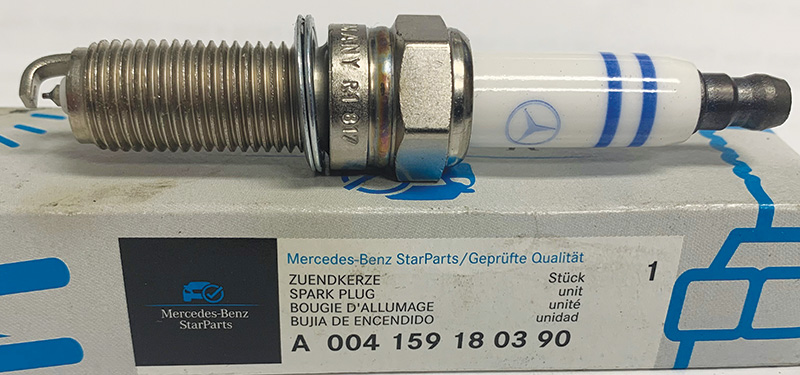
Use the Right Part!
It is important to understand that not all spark plugs are created equal. Your local independent parts suppliers may show a particular spark plug for the model of Mercedes-Benz you are servicing, and they even may say they meet OE specifications, but they are not always the same! According to a technical update from the Mercedes-Benz USA’s QEC/ES department a critical difference is noted particularly in the spark plugs used in direct-injected engines (such as M276, M278 and M157). The indexing of aftermarket plugs is not the same and can cause detonation and even melted pistons. Be sure to use only genuine Mercedes-Benz spark plugs to avoid engine failure.
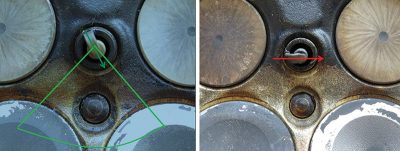
In addition to the various types of electrode configurations, spark plugs will basically have two types of seats that contact the entrance to the combustion chamber: Flat (or level) seat, where a captive outer gasket acts as a seal around the plug body, or tapered (or conical) seat, where the conical surface of the plug body fits into a correspondingly shaped contact surface in the cylinder head to create a seal. Knowing which of these two you have is important when it comes to installation methods, which we will discuss in a moment.
Removal and Installation
Not much has changed over the years in the actual removal and replacement of spark plugs. They still screw into the cylinder head as always. Access is always the issue: Can you get to it without removing the engine? In most newer Mercedes-Benz engines, carefully removing the coils provides access to the spark plugs themselves for servicing. A high quality thin-walled deep socket, perhaps with a swivel end for easier access and a spark plug retention feature, is needed. Note that some models have the newer bi-hex 14mm 12-point head spark plugs, so you’ll want to have one of those sockets in your arsenal. When in doubt as to access to the spark plugs, consult the repair manual for the model you are working on.
Proper torque is absolutely critical to seating the spark plug to ensure good contact with the seat and to ensure it doesn’t back out over time due to expansion and contraction. Too tight can also be a problem as this can lead to cracking of the porcelain, not to mention not being able to remove it later. In the old days we could just install the spark plugs what we called “gootentight,” but today you really must observe the torque specs for the application.
A few cautions before beginning work:
- The ignition system needs to be off (obviously).
- Before removing the spark plugs, be sure to blow out the spark plug wells in order to prevent any loose debris from entering the combustion chamber.
- When servicing Mercedes-AMG engines M133, M176, M177 and M178, the spark plug wells need to be vacuumed out after removing the spark plugs to ensure no particles whatsoever remain on the seats.
- It is important on all engines that no particles interfere with the spark plug’s ability to seat in the cylinder head properly. Look carefully with a bright light or borescope.
- All ignition components which are worked on during the spark plug change should be visually inspected for damage and repaired or replaced as necessary.
- Before installation, the rubber tips of the spark plug connectors must be greased with an approved dielectric silicone grease, such as Mercedes-Benz part A002 989 80 51 09. This facilitates easier installation and removal, and helps prevent carbon tracking.
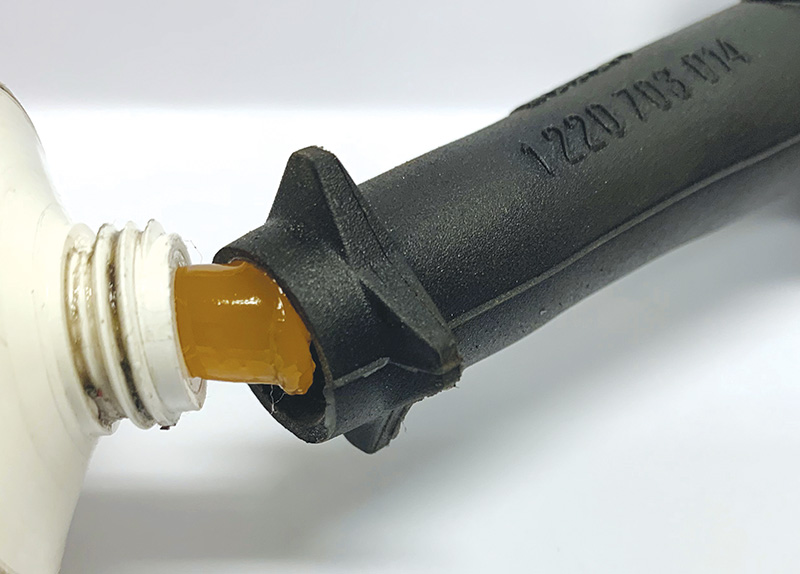

Carbon Tracking and Corona Stain
We mentioned carbon tracking above in the use of dielectric grease. Electricity follows the path of least resistance and when diagnosing misfires be careful to examine the ceramic portion of the plug for a black “track” from the tip to the hex portion. This is burned in and cannot be removed. If you find this when doing a spark plug service is wise to carefully inspect and or replace the coil boot as it may be damaged as well.

Corona stain is a light brown or tan discoloration on the outside of the ceramic insulator above the metal shell/hex. Corona stain is created by the high voltage traveling thru the plug that attracts the dirt or oil particles surrounding the exposed ceramic insulator between the wire/coil boot and spark plug metal shell. Corona stain is completely normal and should not be mistaken for exhaust gas blow-by or a broken seal inside the spark plug.
Gap
As mentioned earlier, the spark plug gap is the distance between the outer or ground electrode and the inner electrode. Since the gap dimension has a direct effect on the voltage necessary to jump the gap and ionize (ignite) the air-fuel mixture, careful attention is required. While most plugs are pre-gapped from the factory, it is imperative to closely inspect the box and the plugs for damage and any obvious discrepancy in the gaps. Genuine Mercedes-Benz Spark plugs should not need to be gapped. If you find one that is way off it’s best to exchange it for another, although small variances can be adjusted with a high quality spark plug gapping tool. The voltage requirement is directly proportional to the gap size and has been determined by the engineers for the specific engine and model. Don’t try to run with a wider gap thinking better spark! That’s an old racer’s myth and won’t give very good results.
If the gap must be adjusted, use a tool that only moves the ground electrode and does not pry between or against the electrodes. NGK also recommends adjusting the gap no more than +/- 0.008” from the factory preset gap.
To Anti-seize or Not
That is the question! Many technicians, especially those who have experience with air cooled engines, advocate using an anti-seize product on the threads of the spark plugs. The reasoning behind the practice is due to the nature of the two dissimilar metals — the steel outer jacket of the spark plug and the aluminum alloy of the cylinder head — there can be expansion and contraction between the different metals and spark plugs tend to get “stuck” in the cylinder head and even break off, necessitating a costly repair.
According to NGK (and others echo the same thing), their spark plugs feature tri-valent plating. This silver or chrome-colored finish on the threads is designed to provide corrosion resistance against moisture and chemicals. The coating also acts as a release agent during spark plug removal. NGK spark plugs are installed at the factory dry, without lubrication or anti-seize.
Anti-seize can act as a lubricant, altering torque values by up to 20 percent, increasing the risk of spark plug thread breakage, metal shell stretch, and/or incorrect indexing. Thread breakage can sometimes involve removing the cylinder head for repair. Metal shell stretch changes the heat rating of the spark plug and can result in serious engine damage caused by pre-ignition. Bottom line: Do not use anti-seize or lubricant on spark plug threads. It is completely unnecessary and can be detrimental. If you were taught to use anti-seize, now you know better and need to stop.
So there you have it: The humble spark plug has more to it than meets the eye. Use the right plug for the application, pay attention to the basics, keep that torque wrench handy, and your customers will never need to worry about a spark plug as a source of trouble.

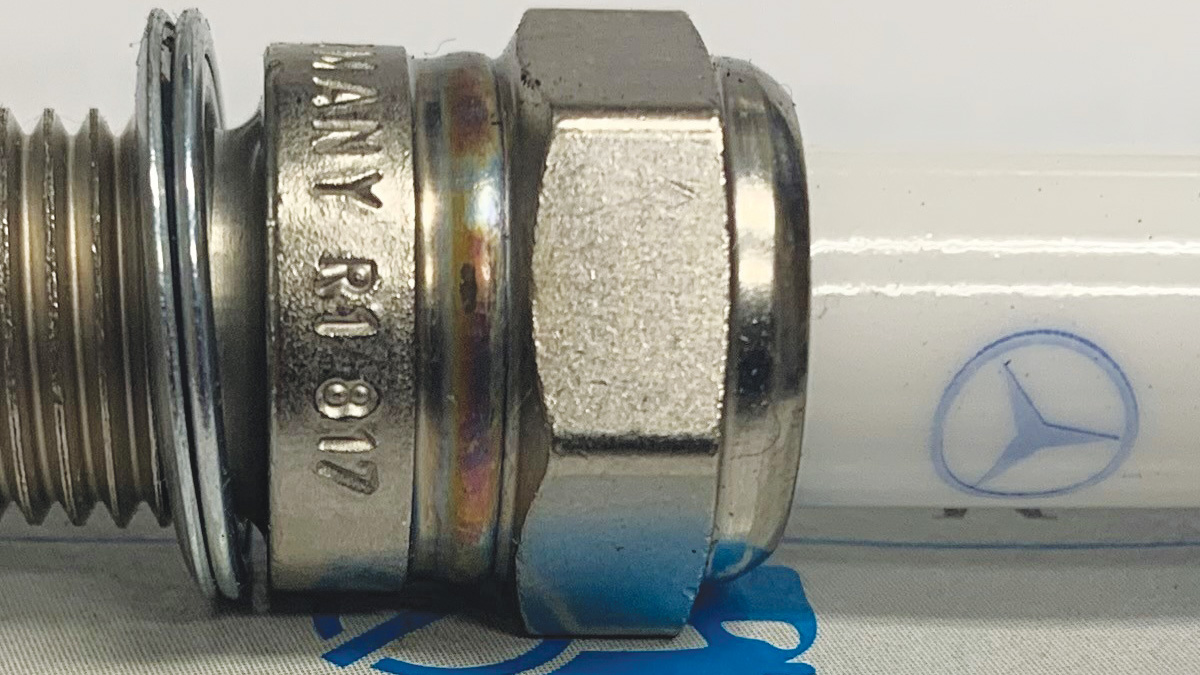

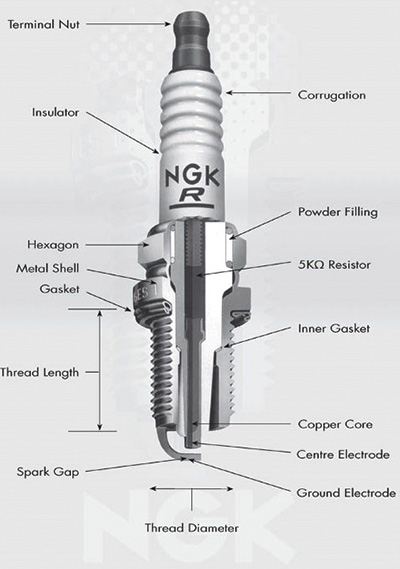
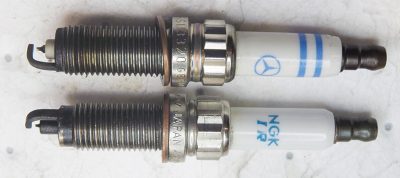
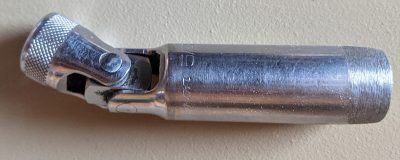





In the M157 engine, WIS does not state anything about the direction of the electrode gap. Also, for me it was impossible to see anything after I put the spark plug on to tell what direction it is in. Is there any best practices in spark plug installs for the M157 anyone knows of?
The “Mercedes-Benz Spark Plug Indexing for Direct Injection Engines” Bulletin explains that on all direct injected MB engines (of which the M157 is), you should use only genuine MB spark plugs. To check your index put a mark on the porcelain in the direction of the electrode to see where it faces when installed. You may need a mirror to see it in its recess. We’ve added a button (above) to download the Spark Plug bulletin. We hope that helps.